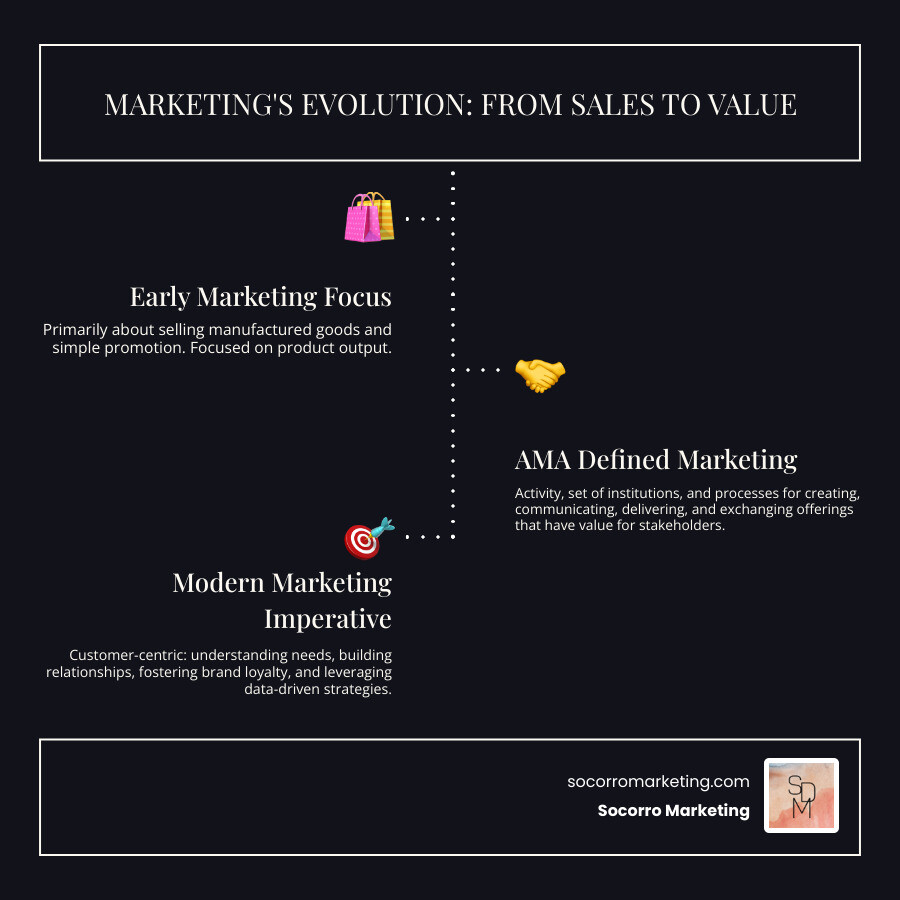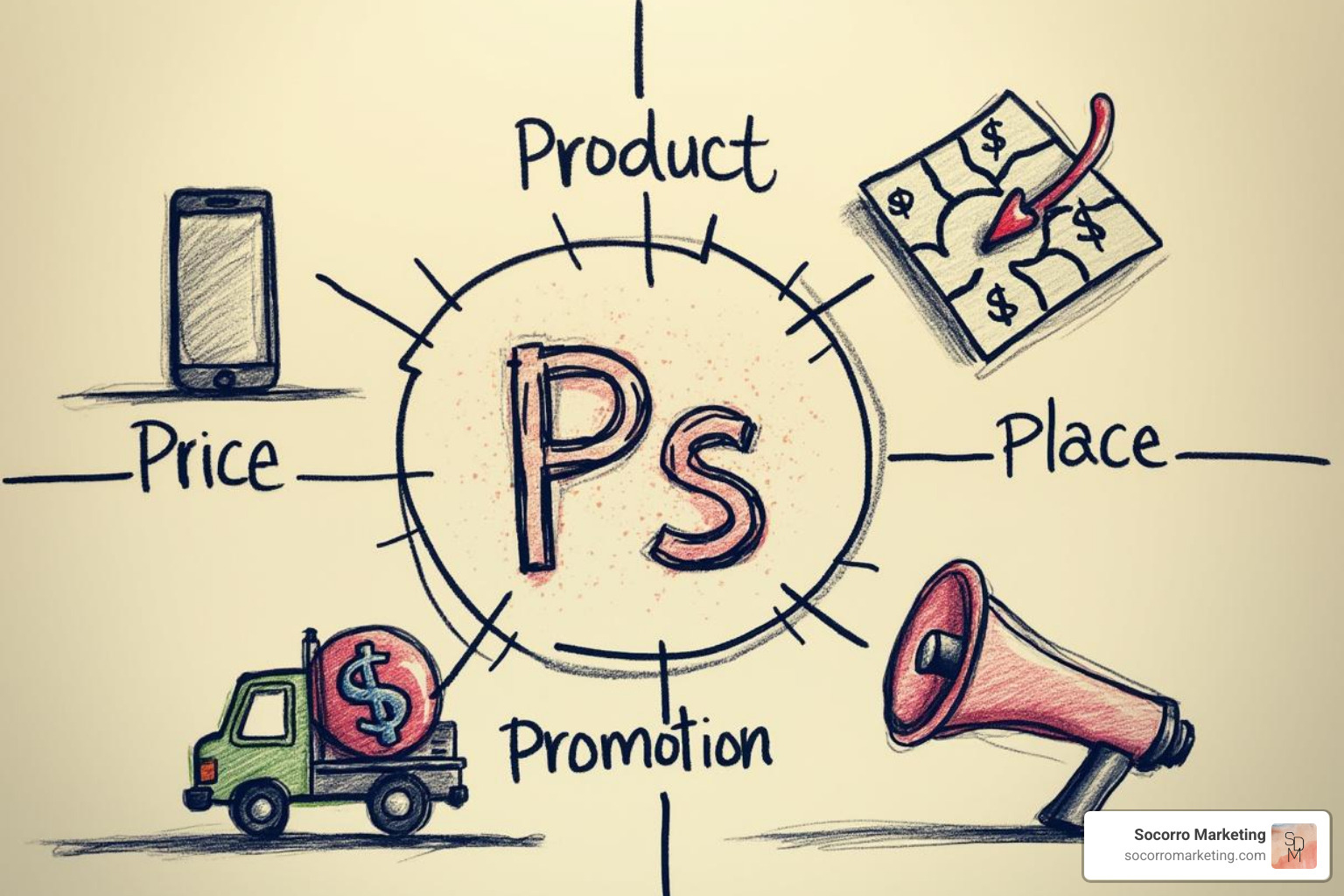At its core, marketing is the comprehensive process by which businesses create, communicate, deliver, and exchange valuable offerings to attract, satisfy, and retain customers. It's the strategic backbone of any successful business, helping it connect with an audience, build relationships, and drive growth.
Without effective marketing, even the best products or services can fail to find their market. In today's competitive landscape, where specialized agencies like Cardinal Digital Marketing focus on large-scale digital campaigns and Intrepy Healthcare Marketing targets specific medical niches, a strong, unique strategy is more crucial than ever. The definition of marketing has evolved from simple promotion to a complex, data-driven science involving psychology and technology. As the American Marketing Association (AMA) has refined its definition, the focus has shifted from just selling products to understanding customer needs, building lasting relationships, and creating genuine value.
As an RN with an MBA, Grace Ascione specializes in healthcare marketing, blending clinical understanding with over 15 years of experience in lead generation and digital strategy. She helps healthcare providers optimize their online presence, ensuring their content speaks directly to consumers ready to book appointments.

This shift underscores a fundamental truth: a strong marketing strategy is not just about flashy ads. It's about strategically positioning your brand to stand out. The vast professional community dedicated to advancing marketing practices, evidenced by forums like the r/marketing subreddit (in the Top 1% by size), highlights the field's continuous evolution and importance.
How do businesses get their products and services to the people who want them? The answer lies in the marketing mix—a strategic toolkit for bringing an offering to market. Over the years, experts have developed frameworks to explain this mix, with the goal of connecting what a business offers with the people who need it most.

Introduced by E. Jerome McCarthy in 1960, the 4Ps look at marketing from the business's point of view.
Product: This is what you sell—a physical item, service, or experience. It encompasses features, design, packaging, and post-purchase support.
Price: This is the amount a customer pays. Setting it requires balancing production costs, competitor pricing, and perceived value.
Place: Also known as distribution, this is how your product reaches the customer. It can be a physical store, an online shop, or both, with the goal of making access easy for your target audience.
Promotion: This is how you communicate your product's value. It includes advertising, public relations, sales, and direct selling. Apple's iconic 'Think different' campaign is a prime example, as detailed in The Real Story Behind Apple's 'Think different' Campaign, which appealed to ideals, not just features.
The 4Ps provided a solid foundation, but their business-centric focus led to a new, more customer-focused model.
In 1990, Robert F. Lauterborn proposed the 4Cs, shifting the perspective from the business to the customer.
Consumer (instead of Product): This framework starts with the Consumer's needs and wants. As marketing expert Philip Kotler noted, true marketing is about knowing what to make, not just selling what you've made.
Cost (instead of Price): This considers the total Cost to the customer, including money, time, and effort. It's about the overall sacrifice made to obtain the product.
Convenience (instead of Place): This focuses on how easy it is for the customer to buy the product. Is the purchasing process smooth and accessible?
Communication (instead of Promotion): This emphasizes a two-way dialogue with customers. As Flint McGlaughlin said, "People don't want to be 'marketed TO'; they want to be 'communicated WITH.'" It's about building relationships.
Here's a quick comparison of the two frameworks:
| 4Ps (Producer-Centric) | 4Cs (Customer-Centric) |
|---|---|
| Product | Consumer Needs & Wants |
| Price | Cost to Satisfy |
| Place | Convenience |
| Promotion | Communication |
While the 4Ps remain relevant, the 4Cs encourage a more empathetic, customer-centric approach, which is essential for building lasting connections in today's market.
A winning marketing strategy needs a solid plan, much like a map for a journey. A marketing plan, aligned with your business goals, outlines who you're trying to reach and how you'll get there. This planning involves environmental scanning—analyzing internal and external factors.
Externally, PESTLE analysis helps understand macro-level forces: Political, Economic, Social, Technological, Legal, and Environmental. Internally, you assess your own strengths and weaknesses. This complete picture allows you to use the STP model (Segmentation, Targeting, and Positioning) to focus your efforts for maximum impact.
Before any campaign, you must know who you're talking to. Marketing research is the process of gathering information from customers and the public to identify opportunities and solve problems. Once you have this data, you can segment your market—dividing a broad audience into smaller groups with shared characteristics. This allows for custom messaging that resonates more deeply.
Common segmentation methods include:
A viable target segment should be DAMP: Discernable, Accessible, Measurable, and Profitable. At Socorro Marketing, our deep healthcare knowledge allows us to effectively segment patient populations, creating strategies like a Best SEO Strategy for Increasing Website Traffic that truly connects.
Products, like people, have a life cycle. Your marketing strategy must adapt as a product moves through its four stages.
Understanding the Product Life Cycle (PLC) helps you anticipate market changes and ensure your marketing efforts are always relevant.
The marketing landscape is vast, constantly evolving with technology and consumer behavior. Strategies can be broadly categorized as traditional (billboards, TV) or digital (social media, websites). Another key distinction is between inbound marketing (attracting customers with valuable content) and outbound marketing (proactively reaching out to customers).
Understanding transaction models helps tailor marketing efforts:
Promotional methods are the tools used to communicate value. While traditional methods still exist, digital channels now dominate.
The shift to digital marketing has been transformative, enabling precise tracking, real-time adjustments, and data-driven decisions that were previously impossible.
How do you know if your marketing strategy is working? Measuring your return on investment (ROI) is critical to ensure every marketing dollar is spent effectively. While it can be challenging to connect spending directly to the bottom line, focusing on key metrics provides a clear picture of success.
Marketing Analytics tools like Google Analytics are essential for gathering this data. They provide deep insights into website traffic, user behavior, and conversion paths, allowing for continuous optimization. This isn't a one-time task; it's an ongoing process of analysis and adjustment. The industry is also embracing technology like AI to automate tasks and improve efficiency.
At Socorro Marketing, we help you steer these metrics. If you're Struggling with Google Ads, we can help you make sense of the data and optimize your strategy. With trillions projected to be spent on marketing globally, effective ROI measurement is essential for survival and growth.
As marketing evolves, questions are natural. Here are answers to some common ones.
Think of marketing as the entire strategic process of bringing a product to market and connecting with customers. It includes research, product development, pricing, distribution, and building relationships. Advertising is just one component of marketing—specifically, the paid promotion used to broadcast a message. In short, all advertising is marketing, but not all marketing is advertising.
Digital technology has revolutionized marketing in several key ways:
If one element had to be chosen, it would be deeply understanding the customer. Without knowing who your customers are, what they need, and how they behave, all other marketing efforts are just guesswork. As expert Philip Kotler said, "Authentic marketing isn't the art of selling what you make but knowing what to make."
However, a great strategy relies on the synergy of all its parts working together—from research and positioning to execution and measurement. This holistic approach builds brand loyalty, drives sales, and creates a sustainable competitive edge.
We've journeyed through marketing, from its core definitions to the strategies that drive success. It's clear that modern marketing is a blend of art and science—a customer-focused discipline essential for business growth. The key takeaway is to deeply understand your customers, remain adaptable, and consistently deliver real value.
At Socorro Marketing, we put these principles into practice every day. Based in Golden, CO, and serving clients across Utah, Arizona, New Mexico, and Colorado, we specialize in marketing for healthcare businesses. Our unique, nurse-managed approach provides deep clinical insight that informs our lead generation, SEO, and ad services. We understand the healthcare consumer's journey and help small practices connect with them effectively.
The world of marketing is dynamic and challenging, but also incredibly rewarding. By continuously learning and applying these core principles, you can achieve brilliant results. Ready to lift your strategy? Explore our comprehensive digital marketing services and let us help you build meaningful connections with your audience.